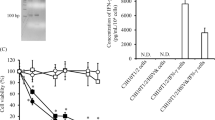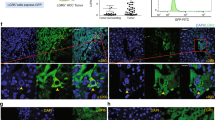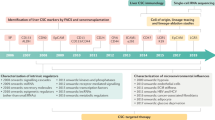Abstract
Stem cells have received a great deal of attention for their clinical and therapeutic potential for treating human diseases and disorders. Recent studies have shown that it is possible to genetically engineered stem cells (GESTECs) to produce suicide enzymes that convert non-toxic prodrugs to toxic metabolites, selectively migrate toward tumor sites and reduce tumor growth. In this study, we evaluated whether these GESTECs are capable of migrating to hepatocarcinoma cells and examined the potential therapeutic efficacy of gene-directed enzyme prodrug therapy against liver cancer cells in cellular and animal models. A modified transwell migration assay was performed to determine the migratory capacity of GESTECs to Hep3B hepatocarcinoma cells. GESTECs, that is, HB1.F3.CD or HB1.F3.CD.interferon-β (IFN-β) cells, engineered to express a suicide gene, cytosine deaminase (CD), selectively migrated toward liver cancer cells. Treatment of Hep3B, human liver cancer cells, with the prodrug 5-fluorocytosine (5-FC) in the presence of HB1.F3.CD or HB1.F3.CD.IFN-β cells resulted in the inhibition of Hep3B cell growth. In a xenografted mouse model injected with hepatocarcinoma, we investigated the therapeutic effect of these stem cells. For 9 weeks, the xenografted mice were treated with HB1.F3.CD or HB1.F3.CD.IFN-β in the presence of 5-FC. A growth of tumor mass was inhibited about 40–50% in the mice treated with GESTECs and a prodrug. In addition, we further confirmed the cytotoxic effect on tumor cells by histological analysis and migratory effect of therapeutic stem cells. Taken together, GESTECs expressing a fusion gene encoding CD and IFN-β may exert a synergistic antitumor effect on this type of tumor.
This is a preview of subscription content, access via your institution
Access options
Subscribe to this journal
Receive 12 print issues and online access
$259.00 per year
only $21.58 per issue
Buy this article
- Purchase on Springer Link
- Instant access to full article PDF
Prices may be subject to local taxes which are calculated during checkout






Similar content being viewed by others
References
Parkin DM, Bray F, Ferlay J, Pisani P . Global cancer statistics, 2002. CA Cancer J Clin 2005; 55: 74–108.
Bosch FX, Ribes J, Diaz M, Cleries R . Primary liver cancer: worldwide incidence and trends. Gastroenterology 2004; 127 (5 Suppl 1): S5–S16.
Biasco G, Gallerani E . Treatment of liver metastases from colorectal cancer: what is the best approach today? Dig Liver Dis 2001; 33: 438–444.
Shen DW, Lu YG, Chin KV, Pastan I, Gottesman MM . Human hepatocellular carcinoma cell lines exhibit multidrug resistance unrelated to MRD1 gene expression. J Cell Sci 1991; 98 (Part 3): 317–322.
Yamaguchi F, Kamitori K, Sanada K, Horii M, Dong Y, Sui L et al. Rare sugar D-allose enhances anti-tumor effect of 5-fluorouracil on the human hepatocellular carcinoma cell line HuH-7. J Biosci Bioeng 2008; 106: 248–252.
Reiser J, Zhang XY, Hemenway CS, Mondal D, Pradhan L, La Russa VF . Potential of mesenchymal stem cells in gene therapy approaches for inherited and acquired diseases. Expert Opin Biol Ther 2005; 5: 1571–1584.
Kucerova L, Altanerova V, Matuskova M, Tyciakova S, Altaner C . Adipose tissue-derived human mesenchymal stem cells mediated prodrug cancer gene therapy. Cancer Res 2007; 67: 6304–6313.
Studeny M, Marini FC, Champlin RE, Zompetta C, Fidler IJ, Andreeff M . Bone marrow-derived mesenchymal stem cells as vehicles for interferon-beta delivery into tumors. Cancer Res 2002; 62: 3603–3608.
Aboody KS, Najbauer J, Schmidt NO, Yang W, Wu JK, Zhuge Y et al. Targeting of melanoma brain metastases using engineered neural stem/progenitor cells. Neuro Oncol 2006; 8: 119–126.
Saukkonen K, Hemminki A . Tissue-specific promoters for cancer gene therapy. Expert Opin Biol Ther 2004; 4: 683–696.
Evoy D, Hirschowitz EA, Naama HA, Li XK, Crystal RG, Daly JM et al. In vivo adenoviral-mediated gene transfer in the treatment of pancreatic cancer. J Surg Res 1997; 69: 226–231.
Kanai F, Lan KH, Shiratori Y, Tanaka T, Ohashi M, Okudaira T et al. In vivo gene therapy for alpha-fetoprotein-producing hepatocellular carcinoma by adenovirus-mediated transfer of cytosine deaminase gene. Cancer Res 1997; 57: 461–465.
Crystal RG, Hirschowitz E, Lieberman M, Daly J, Kazam E, Henschke C et al. Phase I study of direct administration of a replication deficient adenovirus vector containing the E. coli cytosine deaminase gene to metastatic colon carcinoma of the liver in association with the oral administration of the pro-drug 5-fluorocytosine. Hum Gene Ther 1997; 8: 985–1001.
Kim KY, Kim SU, Leung PC, Jeung EB, Choi KC . Influence of the prodrugs 5-fluorocytosine and CPT-11 on ovarian cancer cells using genetically engineered stem cells: tumor-tropic potential and inhibition of ovarian cancer cell growth. Cancer Sci 2010; 101: 955–962.
Etienne MC, Cheradame S, Fischel JL, Formento P, Dassonville O, Renée N et al. Response to fluorouracil therapy in cancer patients: the role of tumoral dihydropyrimidine dehydrogenase activity. J Clin Oncol 1995; 13: 1663–1670.
Kim KY, Park DW, Jeung EB, Choi KC . Conditional knockout of brca1/2 and p53 in mouse ovarian surface epithelium: do they play a role in ovarian carcinogenesis? J Vet Sci 2010; 11: 291–297.
Freytag SO, Khil M, Stricker H, Peabody J, Menon M, DePeralta-Venturina M et al. Phase I study of replication-competent adenovirus-mediated double suicide gene therapy for the treatment of locally recurrent prostate cancer. Cancer Res 2002; 62: 4968–4976.
Chung-Faye GA, Chen MJ, Green NK, Burton A, Anderson D, Mautner V et al. In vivo gene therapy for colon cancer using adenovirus-mediated, transfer of the fusion gene cytosine deaminase and uracil phosphoribosyltransferase. Gene Ther 2001; 8: 1547–1554.
Aboody KS, Brown A, Rainov NG, Bower KA, Liu S, Yang W et al. Neural stem cells display extensive tropism for pathology in adult brain: evidence from intracranial gliomas. Proc Natl Acad Sci USA 2000; 97: 12846–12851.
Aboody KS, Bush RA, Garcia E, Metz MZ, Najbauer J, Justus KA et al. Development of a tumor-selective approach to treat metastatic cancer. PLoS One 2006; 1: e23.
Kim SK, Kim SU, Park IH, Bang JH, Aboody KS, Wang KC et al. Human neural stem cells target experimental intracranial medulloblastoma and deliver a therapeutic gene leading to tumor regression. Clin Cancer Res 2006; 12: 5550–5556.
Kim SU, Nakagawa E, Hatori K, Nagai A, Lee MA, Bang JH . Production of immortalized human neural crest stem cells. Methods Mol Biol 2002; 198: 55–65.
Kim SU . Human neural stem cells genetically modified for brain repair in neurological disorders. Neuropathology 2004; 24: 159–171.
Yi BR, O SN, Kang NH, Hwang KA, Kim SU, Jeung EB et al. Genetically engineered stem cells expressing cytosine deaminase and interferon-beta migrate to human lung cancer cells and have potentially therapeutic anti-tumor effects. Int J Oncol 2011; 39: 833–839.
Nagano H, Miyamoto A, Wada H, Ota H, Marubashi S, Takeda Y et al. Interferon-alpha and 5-fluorouracil combination therapy after palliative hepatic resection in patients with advanced hepatocellular carcinoma, portal venous tumor thrombus in the major trunk, and multiple nodules. Cancer 2007; 110: 2493–2501.
Kashiwagi K, Furusyo N, Kubo N, Nakashima H, Nomura H, Kashiwagi S et al. A prospective comparison of the effect of interferon-alpha and interferon-beta treatment in patients with chronic hepatitis C on the incidence of hepatocellular carcinoma development. J Infect Chemother 2003; 9: 333–340.
Hisaka T, Yano H, Ogasawara S, Momosaki S, Nishida N, Takemoto Y et al. Interferon-alphaCon1 suppresses proliferation of liver cancer cell lines in vitro and in vivo. J Hepatol 2004; 41: 782–789.
Rosser AE, Zietlow R, Dunnett SB . Stem cell transplantation for neurodegenerative diseases. Curr Opin Neurol 2007; 20: 688–692.
Kucerova L, Matuskova M, Pastorakova A, Tyciakova S, Jakubikova J, Bohovic R et al. Cytosine deaminase expressing human mesenchymal stem cells mediated tumour regression in melanoma bearing mice. J Gene Med 2008; 10: 1071–1082.
Boucher PD, Im MM, Freytag SO, Shewach DS . A novel mechanism of synergistic cytotoxicity with 5-fluorocytosine and ganciclovir in double suicide gene therapy. Cancer Res 2006; 66: 3230–3237.
Barresi V, Belluardo N, Sipione S, Mudo G, Cattaneo E, Condorelli DF . Transplantation of prodrug-converting neural progenitor cells for brain tumor therapy. Cancer Gene Ther 2003; 10: 396–402.
Ehtesham M, Yuan X, Kabos P, Chung NH, Liu G, Akasaki Y et al. Glioma tropic neural stem cells consist of astrocytic precursors and their migratory capacity is mediated by CXCR4. Neoplasia 2004; 6: 287–293.
Sun L, Hui AM, Su Q, Vortmeyer A, Kotliarov Y, Pastorino S et al. Neuronal and glioma-derived stem cell factor induces angiogenesis within the brain. Cancer Cell 2006; 9: 287–300.
Sun L, Lee J, Fine HA . Neuronally expressed stem cell factor induces neural stem cell migration to areas of brain injury. J Clin Invest 2004; 113: 1364–1374.
Schmidt NO, Przylecki W, Yang W, Ziu M, Teng Y, Kim SU et al. Brain tumor tropism of transplanted human neural stem cells is induced by vascular endothelial growth factor. Neoplasia 2005; 7: 623–629.
Beppu K, Jaboine J, Merchant MS, Mackall CL, Thiele CJ . Effect of imatinib mesylate on neuroblastoma tumorigenesis and vascular endothelial growth factor expression. J Natl Cancer Inst 2004; 96: 46–55.
Dar A, Goichberg P, Shinder V, Kalinkovich A, Kollet O, Netzer N et al. Chemokine receptor CXCR4-dependent internalization and resecretion of functional chemokine SDF-1 by bone marrow endothelial and stromal cells. Nat Immunol 2005; 6: 1038–1046.
Cheng Z, Ou L, Zhou X, Li F, Jia X, Zhang Y et al. Targeted migration of mesenchymal stem cells modified with CXCR4 gene to infarcted myocardium improves cardiac performance. Mol Ther 2008; 16: 571–579.
Martin L, Schilder R . Novel approaches in advancing the treatment of epithelial ovarian cancer: the role of angiogenesis inhibition. J Clin Oncol 2007; 25: 2894–2901.
Ueoka Y, Kato K, Wake N . Hepatocyte growth factor modulates motility and invasiveness of ovarian carcinomas via ras mediated pathway. Mol Cell Endocrinol 2003; 202: 81–88.
Scotton CJ, Wilson JL, Scott K, Stamp G, Wilbanks GD, Fricker S et al. Multiple actions of the chemokine CXCL12 on epithelial tumor cells in human ovarian cancer. Cancer Res 2002; 62: 5930–5938.
Yi BR, Kang NH, Hwang KA, Kim SU, Jeung EB, Choi KC . Antitumor therapeutic effects of cytosine deaminase and interferon-beta against endometrial cancer cells using genetically engineered stem cells in vitro. Anticancer Res 2011; 31: 2853–2861.
Miller CR, Williams CR, Buchsbaum DJ, Gillespie GY . Intratumoral 5-fluorouracil produced by cytosine deaminase/5-fluorocytosine gene therapy is effective for experimental human glioblastomas. Cancer Res 2002; 62: 773–780.
Huber BE, Austin EA, Richards CA, Davis ST, Good SS . Metabolism of 5-fluorocytosine to 5-fluorouracil in human colorectal tumor cells transduced with the cytosine deaminase gene: significant antitumor effects when only a small percentage of tumor cells express cytosine deaminase. Proc Natl Acad Sci USA 1994; 91: 8302–8306.
Ito S, Natsume A, Shimato S, Ohno M, Kato T, Chansakul P et al. Human neural stem cells transduced with IFN-beta and cytosine deaminase genes intensify bystander effect in experimental glioma. Cancer Gene Ther 2010; 17: 299–306.
Acknowledgements
This work was supported by the National Research Foundation of Korea (NRF) grant funded by the Korea government (MEST) (No. 2010-0003093).
Author information
Authors and Affiliations
Corresponding author
Ethics declarations
Competing interests
The authors declare no conflict of interest.
Rights and permissions
About this article
Cite this article
Yi, BR., Hwang, KA., Kang, NH. et al. Synergistic effects of genetically engineered stem cells expressing cytosine deaminase and interferon-β via their tumor tropism to selectively target human hepatocarcinoma cells. Cancer Gene Ther 19, 644–651 (2012). https://doi.org/10.1038/cgt.2012.45
Received:
Revised:
Accepted:
Published:
Issue Date:
DOI: https://doi.org/10.1038/cgt.2012.45
Keywords
This article is cited by
-
Cytotoxic effect of co-expression of human hepatitis A virus 3C protease and bifunctional suicide protein FCU1 genes in a bicistronic vector
Molecular Biology Reports (2017)
-
Anticancer effects of the engineered stem cells transduced with therapeutic genes via a selective tumor tropism caused by vascular endothelial growth factor toward HeLa cervical cancer cells
Molecules and Cells (2013)



